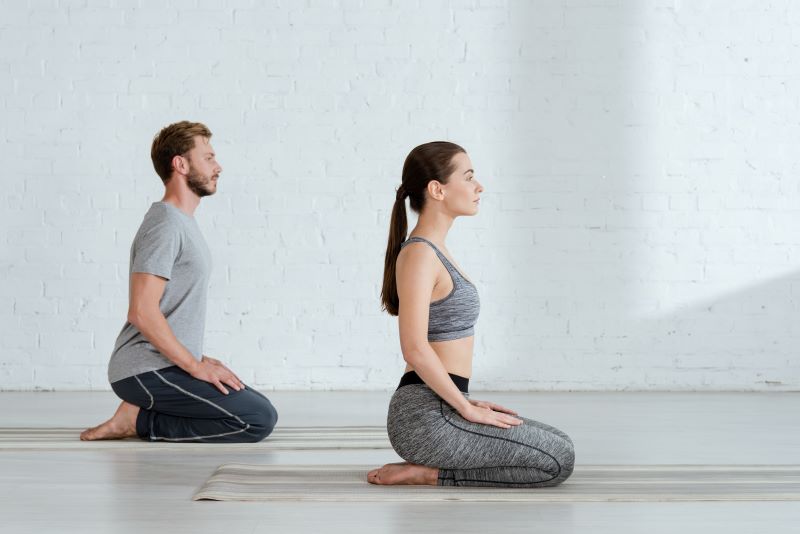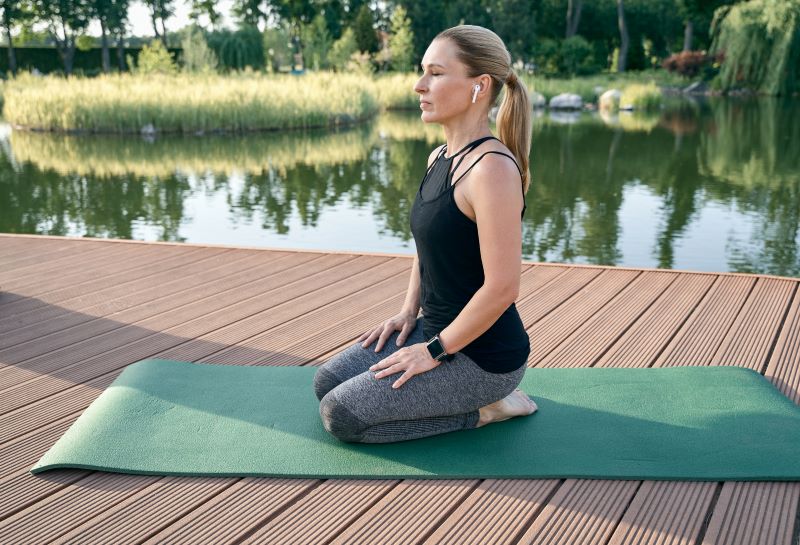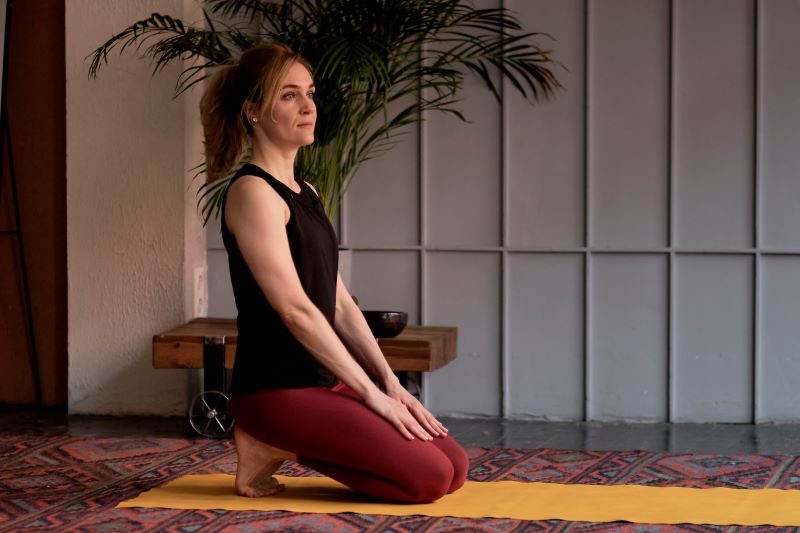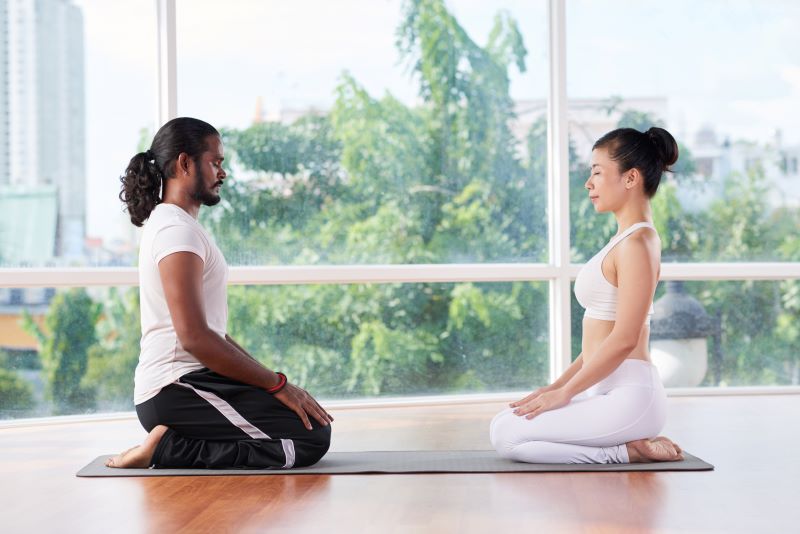15 Health Benefits of Vajrasana & How to Do It?

Elaborate working hours, less sleep, and fatty foods are reducing our physical activities to zero. As a result, we are developing complicated issues in our bodies, like obesity, rising cholesterol levels, and anxiety issues.
To combat these health issues, Thunderbolt Pose or Vajrasana can be very helpful. It relaxes your muscles, improves posture, and restores the digestive system. Read to the end to learn what it is, the benefits of Vajrasana, the procedure, and the precautions!

Table of Contents

What is Vajrasana (Thunderbolt Pose)?
In Sanskrit, ‘Vajra’ means Thunder, and ‘Asana’ means posture. Deriving its name from the Hindu God of Thunder, Lord Indra’s weapon Vajra, this yoga pose has multiple benefits for your mind and muscles.
Vajra Nadi (nerves), the primary nervous of humans, also adds relevance to Yogasana’s name. Nerves run in our body like a thunder network, and this asana impacts our mind, thus the name Vajrasana.
Also popular as thunderbolt or diamond pose, you can practise Vajrasana after a day’s meal.
How to Perform Vajrasana?
To perform this yoga, follow the below procedure for Vajrasana. It has been mentioned in steps for clarity:
Step 1: Sit on a yoga mat in a kneeling position.
Step 2: Take your weight from your knees as you sit back on your legs.
Step 3: Let your butt rest on your heels and thigh on your calves. If it is your first time, you may feel a straining pressure on your ankle.
Step 4: Keep your back straight, gaze forward and fix it on a particular thing right before you. Also, keep your head straight and your chin parallel to the ground.
Step 5: Place your hands on your lap, palms facing upwards or downwards, as you prefer. You can also join your hands in a praying posture to absorb the positive aura around you.
Step 6: Pull your attention away from the surroundings and focus on your breathing as you sit in this posture. Take slow, deep breaths and let your mind focus on the rhythmic breathing as you try blocking other thoughts.
Step 7: At the initial stages, hold this position for 5-10 minutes. Gradually, you can increase it to 30 minutes or more as you practise and improve.
15 Health Benefits of Vajrasana
Following are the top 10 benefits of Vajrasana on your health:
1. Improves Digestion
Vajrasana is the only Yoga Pose you can perform after lunch or dinner, and it benefits your digestive process in several ways.
Performing Vajrasana after a meal, such as lunch or dinner, ensures proper bowel movement while eliminating constipation. This asana also reduces gas and acidity disorders in the body.
Sitting in Vajrasana posture reduces blood flow in the lower parts of your body. However, it increases blood flow in the stomach and other upper body parts. This, consequently, improves digestion and absorption of nutrients by your body.
2. Prevents Obesity
Obesity is one of the growing issues among today's generation. Unfortunately, owing to today's lifestyle, obesity brings with it multiple diseases and illnesses.
Practising Vajrasana poses daily can help you fight against obesity by ensuring weight loss as your body digests the food.
Moreover, better digestion means your body does not allow fats to be easily stored in the abdominal region. Thereby, it ensures weight loss while driving away obesity.
3. Helps Reduce Menstrual Cramps
Although periods are regular and occur every month, menstrual cramps can be hard to bear for several women. In addition, these cramps are so excruciating that most women opt for painkillers, which are long-term harmful.
So, what is an easy and healthy way to ease period cramps?
Period cramps occur due to the tensing of your uterine muscles. Vajrasana is one of the yoga poses that help relax muscles in your waist region, including your uterus. This consequently eases blood flow and reduces cramps.
4. Increases Concentration
Sitting in the Vajrasana pose and focusing on your breathing helps increase your concentration. Regularly practising Vajrasana poses helps you focus on one subject without getting distracted easily.
5. Helps Fight Against Anxiety
Like every other Yogasana, Vajrasana too involves repetitive and rhythmic deep breathing. Focussing on your breathing during Vajrasana calms your mind and relaxes you from anxiety and stress.
Therefore, try Vajrasana to relax your mind as you inhale positive energy from your surroundings to combat anxiety.
6. Reduces Lower Back Pain
Vajrasana relaxes the muscles in the lower back, helping to lessen lower back pain. It also resolves discomfort and lower back pain caused by sciatica.
7. Helps Keep Blood Sugar Level in Control
Vajrasana stimulates organs like the liver and pancreas. As a result, it boosts insulin production, helping manage your blood sugar level. In addition, diabetes patients can perform Vajrasana to improve fasting glucose levels in their blood.
8. Provides Relief From Rheumatic Pain
Vajrasana enhances the flexibility of our thighs, hips, knees, feet and ankle muscles. If you are facing discomfort due to stiffness in these areas, try practising Vajrasana to relax these muscles.
9. Improves Your REM Cycle
Many people complain of insomnia and sleep disturbances today. Vajrasana yoga is one of the oldest cures for these sleep-related issues.
Performing Vajrasana helps release anxiety and stress as you exhale out all the negative energy while performing this pose. Thereby, you experience a sound sleep.
10. Helps to Improve Posture
While performing Vajrasana, you need to maintain a straight back. Thus, practising it regularly helps you maintain the perfect posture for a long time.
This, in turn, benefits you in sitting straight. Additionally, it improves your concentration and eyesight. Also, it is suitable for your spine. Lastly, sitting with a straight spine lowers back pain and helps lower a hunchback posture.
11. Enhances Blood Circulation
Vajrasana significantly improves blood circulation throughout your body. The seated position reduces blood flow to the legs, redirecting it to the upper body and vital organs. This increased blood flow to the digestive organs enhances nutrient absorption and detoxification, promoting overall health.
12. Boosts Immune System
Regular practice of Vajrasana can help strengthen the immune system. By enhancing digestion and nutrient absorption, Vajrasana ensures your body receives the essential vitamins and minerals needed to maintain a robust immune response. Additionally, the stress-reducing benefits of Vajrasana support overall immune function.
13. Strengthens Pelvic Floor Muscles
Vajrasana is highly beneficial for strengthening the pelvic floor muscles. This can be particularly advantageous for women, as strong pelvic floor muscles support the bladder, uterus, and bowel. For men, it can improve prostate health. A strong pelvic floor also aids in better control and stability during other physical activities.
14. Alleviates Symptoms of Hypertension
Practising Vajrasana regularly can help in managing hypertension. The calming effects of this pose, combined with deep breathing techniques, reduce stress and anxiety levels, which are often contributing factors to high blood pressure. By promoting relaxation and mindfulness, Vajrasana aids in maintaining healthy blood pressure levels.
15. Improves Metabolism
Engaging in Vajrasana can have a positive impact on your metabolic rate. Improved digestion and enhanced blood circulation help improve the assimilation of nutrients, which boosts metabolism. A higher metabolic rate assists in efficient calorie burning, essential for weight management and overall vitality.
The Mudras of Vajrasana (Thunderbolt Pose)
Mudras, or hand gestures, are integral to yoga, enhancing the benefits of poses like Vajrasana. Incorporating specific mudras into Vajrasana can deepen your practice and bring additional physical and mental benefits. Here are four mudras you can integrate with Vajrasana:
1. Chin Mudra
Chin Mudra is a simple yet powerful mudra that symbolises consciousness. To perform it, touch the tip of your thumb to the tip of your index finger while extending the other three fingers. Rest your hands on your thighs with palms facing upward.
Benefits of Chin Mudra: Chin Mudra promotes mental clarity and focus, enhances concentration, and calms the mind during Vajrasana practice.
2. Yoni Mudra
Yoni Mudra represents the womb and is associated with the creative and nurturing energy of the feminine. To perform Yoni Mudra, join your hands before you, touching the tips of your thumbs and index fingers to form a diamond shape. Extend the other fingers downward and interlock them.
Benefits of Yoni Mudra: Yoni Mudra helps centre the mind and reduce stress. It also promotes inner peace and stability, which complements the meditative aspect of Vajrasana.
3. Bhairava Mudra
Bhairava Mudra signifies balance and harmony between masculine and feminine energies. Place your right hand on top of your left hand, palms facing upward, and rest them in your lap.
Benefits of Bhairava Mudra: Bhairava Mudra aids in balancing the dual aspects of your nature, fostering a sense of unity and equilibrium, which is beneficial for holistic wellness during Vajrasana.
4. Hridaya Mudra
Hridaya Mudra is a heart gesture, which activates the heart chakra and enhances emotional balance. To perform it, curl your index finger inward to touch the base of your thumb. Then, join the tips of your thumb, middle, and ring fingers together, extending the little finger outward. Rest your hands on your knees with palms facing upward.
Benefits of Hridaya Mudra: Hridaya Mudra improves emotional well-being and helps release pent-up emotions. It supports heart health and emotional stability during your Vajrasana practice.
5. Anjali Mudra
Anjali Mudra is a hand gesture that symbolises greeting and honour. To apply it in Vajrasana, sit with your spine straight, bring your palms together at the centre of your chest, and press them lightly against each other.
Benefits of Anjali Mudra: Anjali Mudra in Vajrasana helps centre the mind and fosters a sense of calm and peace. It also enhances concentration and brings a sense of gratitude and humility.
Types of Vajrasana
Vajrasana, or the Thunderbolt Pose, has several variations that target different aspects of physical and mental well-being. These variations can add diversity to your practice and help you focus on specific benefits. Here are three types of Vajrasana:
1. Thunderbolt Pose (Vajrasana)

The classic Thunderbolt Pose, known as Vajrasana, is the foundational form of this asana. To perform Vajrasana, sit on your heels with your knees bent and shins flat on the floor. Keep your back straight, hands resting on your thighs, and gaze forward.
2. Toe Squat (Prapadasana)

Toe Squat, or Prapadasana, is a variation of Vajrasana where you balance on your toes. From Vajrasana, lift your heels off the ground and balance on the balls of your feet. Keep your knees together and your back straight while maintaining your balance.
3. Revolved Thunderbolt Pose (Parivrtta Vajrasana)
Parivrtta Vajrasana, also known as Revolved Thunderbolt Pose, is a variation of the standard Vajrasana. Beginning in Vajrasana, twist your torso to the right while placing your left hand on your right knee. For support, rest your right hand on the ground behind you. After maintaining the position, swap sides. This pose tones the digestive organs and improves flexibility in the spine.
Things to Know Before Doing Vajrasana
Before practising Vajrasana, it's essential to be aware of specific considerations to ensure a safe and effective practice. Here are key points to keep in mind:
- Warm-Up: Always warm up gently to get your muscles and joints ready for the pose.
- Avoid on Full Stomach: Although Vajrasana is unique in that it can be performed right after a substantial meal, wait.
- Knee and Ankle Health: Proceed with caution when performing Vajrasana, and think about using modifications if you have any current knee or ankle problems.
- Proper Alignment: Ensure your spine is straight, and your weight is evenly distributed to prevent strain on your back.
- Use of Props: Beginners can use a cushion or folded blanket under their hips to reduce strain on the knees and ankles.
How Long to Hold Vajrasana Pose?

The duration of holding Vajrasana depends on your experience level and comfort level. Here are the recommended durations:
- For Beginners: Start with holding Vajrasana for 5 to 10 minutes. Gradually increase the duration as you become more comfortable with the pose.
- For Intermediate Practitioners: Aim to hold the pose for 15 to 20 minutes. This duration allows you to deepen your practice and experience more benefits.
- For Advanced Practitioners: Hold Vajrasana for 30 minutes or more. Advanced practitioners can use this time for meditation and enhanced mental clarity.
Risks of Overdoing Vajrasana
Overdoing Vajrasana can lead to strain and discomfort, especially if done improperly or for excessive durations. Here are key risks to be aware of:
- Knee Strain: Excessive time in Vajrasana can strain the knee joints, leading to pain and discomfort.
- Ankle Discomfort: Prolonged holding can cause soreness or injury to the ankles due to the intense stretch and pressure.
- Lower Back Pain: Holding the pose for too long without proper alignment can cause lower back pain or exacerbate existing back issues.
- Circulation Issues: Sitting in Vajrasana for extended periods may impede blood circulation in the lower legs, leading to numbness or tingling.
- Digestive Problems: While Vajrasana aids digestion, overdoing it immediately after heavy meals can cause discomfort or exacerbate digestive issues.
Important Tips for Practising Vajrasana
Vajrasana can drastically change your health over time. However, patience and practice are the two important ingredients for reaping its benefits.
Here are a few tips to consider while performing this yoga for effective results:
- Focus on Your Breathing: While performing Vajrasana, you need to narrow your concentration from the surroundings to yourself. You also need to block your chain of thoughts from diverting your attention. To achieve this state, you need to focus on your deep breaths. You can also focus on your heartbeat to get into the zone of total self-awareness. This can seem tough at the start. However, with practice, you can keep your concentration from being diverted.
- Do Not Make Your Body Stiff: Vajrasana helps relax your muscles and, therefore, is an amazing relief from cramps. While performing this asana, your body must not feel any pain or strain, especially in the ankles and knees.
- Sit Up Straight: Keeping your spine straight while doing Vajrasana can lower back pain and improve your posture. Slouching your back, whether intentionally or unintentionally, may feel comfortable. However, later, this can increase your back or neck pain. Therefore, it is necessary to keep your spine straight.
- Lower Your Head: Another common mistake people make while doing Vajrasana is hanging their heads down. You must hold your head up with your chin parallel to the floor while sitting straight. Fix your eye on one object, and do not let your head swing down. Sitting in the wrong posture might lead to neck pain in the future.
- Hold Your Posture for Enough Time: Releasing the Vajrasana posture too soon will not impact you. It may feel uncomfortable at the start, and holding your pose for 5 minutes might seem a hard nut to crack. However, you must be patient and sit for 5 to 10 minutes in the Vajrasana posture. As you gain confidence, slowly increase your time for Vajrasana meditation.
- Choose a Convenient Time: Time plays a great role in meditation. As most meditation is impactful if done on an empty stomach, we usually prefer performing it early in the morning. However, most of us undergo a time crunch to run to work. Therefore, it becomes quite tough to devote some time to yoga.
As we can do Vajrasana after any meal, choosing a convenient time to perform it becomes easy. For instance, if we perform Vajrasana at night after dinner, we can devote quality time to yoga without the rush to work.
What are the Precautions and Contraindications of Vajrasana?
Vajrasana is a complex yoga posture; it is vital to be aware of its precautions and contraindications. If you have any of these medical conditions, you should refrain from practising this yoga.
Shoulder, elbow, knee or wrist injury
Twisted or enlarged veins
Arthritis
Knee pain
If you are pregnant, consult your doctor before trying this eagle pose.
Who Should Avoid Doing Vajrasana?
While Vajrasana offers numerous benefits, individuals should avoid this pose to prevent discomfort or injury. Here are some specific groups who should refrain from practising Vajrasana:
- People with Knee Injuries: Vajrasana puts a lot of strain on the knees, so people who have recently had surgery on their knees, suffered from knee injuries, or have persistent knee pain should avoid it.
- Ankle Problems: Because Vajrasana requires the ankles to bear weight and stretch deeply, it is not recommended for those with chronic ankle pain or injuries to perform the pose.
- Patients with Hernias: Vajrasana should be avoided by those who have them because it can make them worse.
- Severe Sciatica: This pose can exacerbate sciatica, so people with severe sciatica or associated nerve pain should avoid it.
- Pregnant women: To protect their comfort and safety, expectant mothers should avoid Vajrasana, especially in the later stages of their pregnancy, as this poses pressure on the abdomen.
What are the Easy Modifications of Vajrasana?

For beginners, sitting in Vajrasana can be tough. Therefore, you can opt for the following modifications or variations to Vajrasana to warm yourself up:
- Different Knee Poses: If you feel strain in your knees while performing Vajrasana, start out with other sitting asanas like Siddhasana and Janu Sirsasana. In contrast, you can also opt for Dandasana or staff pose to release pressure from the knees. Other easy poses you can begin with are Paschimottanasana (Seated forward bend) or Siddhasana. It will help you get accustomed to Vajrasana.
- Place a Folded Blanket Beneath Your Knees: Take a blanket, fold it several times, and position it below your knees. This will allow your feet to hang down while cushioning your joints, reducing strain on your knees.
- Use a Cushion or Yoga Block In Between Your Feet: To maintain your balance while performing Vajrasana, place a cushion or yoga block between your feet. This will provide your feet with slight support without straining or hurting them.
- Staff Pose to Reduce Stress on Your Knees: If you cannot bend one leg, try extending it straight and bending the other. Sit straight and take deep breaths holding this position. This is the staff pose or Dandasana. It will help release stress from your knees.
Vajrasana is the basic pose for a few other yogasanas like Shishuasana, Gomukhasana and Ustrasana. Practising the pose daily can tap into several benefits of Vajrasana. This pose can cure your body and mind of many complex issues, such as insomnia, anxiety, and body pain. You do not need to opt for expensive medical assistance to get rid of these.













